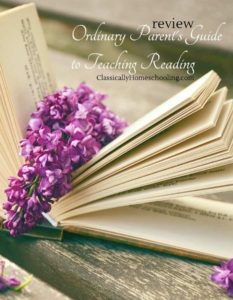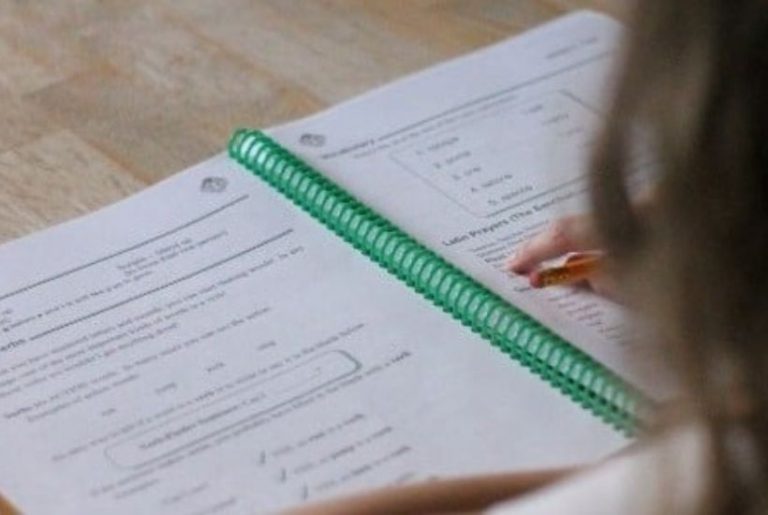Book Review: The Ordinary Parent’s Guide to Teaching Reading
This post may contain affiliate links. For more information, please read my disclosure policy.
My 4-year-old and I aren’t making much progress with Teach Your Child to Read in 100 Easy Lessons, so I checked out The Ordinary Parent’s Guide to Teaching Reading by Jessie Wise and Sara Buffington to give it a test run. Sometimes you need a bit of a change to keep the spark in teaching a large family.
The Ordinary Parent’s Guide to Teaching Reading
The Ordinary Parent’s Guide to Teaching Reading begins by introducing the short vowel sounds over 5 lessons. The next 21 lessons teach consonant sounds.
The Ordinary Parent’s Guide to Teaching Reading
There are two fun rhymes, The Five Vowels and The Consonant Rhymes, to reinforce the names and the sounds in the child’s memory. I enjoyed the early introduction of vowels and consonants.
The lessons begin with a review before moving on to the new information being taught. There is a short blurb before the lesson letting you know of needed materials. Index cards are needed to create flashcards, and magnetic letters are recommended for follow-up or optional activities.

Sometimes other materials are recommended as games, rhymes, or silly songs are used to reinforce the teachings. The lessons are highly scripted.
Each Lesson Teaches New Material
It will be up to the instructor to tell when to pause to allow the material time to become automatic or when to back up to relearn old material. This isn’t a problem as long as the parent knows they’re going to need to stop and drill the new information or back up to relearn it.
The Ordinary Parent’s Guide to Reading covers all the phonics you need to teach. It begins by introducing letter sounds and continues on over 231 lessons to conclude with multi-syllable words.
It also teaches periodic sight words as the children progress. These are words that don’t follow the rules of phonics or need to be introduced early so children can read beginning readers at their level.
The format is different than I’m used to, and the font size is small. The combination of scripted lessons for the instructor and the words for the children to read makes for a busy page. It might be difficult for some children not to be distracted, but this is easily solved with a whiteboard or small chalkboard.
By the end of the book, when the children are reading well, I can see many children reading the instructor’s script instead of their assigned reading. Actually, my 4th child pulled that stunt with me using Phonics Pathways!
All in all, The Ordinary Parent’s Guide to Teaching Reading is an excellent book for teaching a child to read. It will take the child from learning their letter sounds to being able to read almost anything in print.









This book sounds like a great resource!
Thank you for stopping by the Thoughtful Spot Weekly Blog Hop this week. We hope to see you drop by our neck of the woods next week!
What a great resource.
You know, my family always did well with easy. With my son, we used Explode the Code. I know it’s not classical in nature, but it’s so easy to love. It’s uncomplicated. The pictures are big and fun. They are not in color – which I liked. It wasn’t wasteful. It made it very easy to learn.
I moved to Abeka with my daughter because of the cursive component. Abeka works well, but i have simplified it greatly. Really, we didn’t need all the crap and accessories, you know. It has colored pictures and is very wasteful in terms of paper, but our simplified version works.
Simple is best. Simple to understand simple to teach.
Thanks so much for linking up with us on the #homeschoollinkup!
This review is really helpful. I’ve recently started teaching English phonics at a Malay/English bilingual kindergarten so I’ve been looking at phonics curricula until I’m cross-eyed. This one looks good, but my problem continues to be that most, if not all, phonics programs teach kids to decode words they already know the meaning of. It is challenging when you need to be giving meaning and decoding at the same time. Nonetheless, I found this to be a helpful review! Thanks so much for sharing this at Booknificent Thursday! Hope to see you again soon!
Tina
I taught my son to read using the methods in the Writing Road to Reading (introducing the phonograms and then the rules). He is a fantastic reader. With my daughter, I found that I just didn’t have the time or mental energy to make up my own lessons anymore. I was using the Reading Lesson, but found that after a ways into the book I had to explain rules that it just ignored. I found that I really like the All About Reading/Spelling curriculum because it is scripted and teaches the same phonograms and rules as the Writing Road to Reading (as far as I can see). We are only using their spelling book right now, but if I need something more I think I would get the reading curriculum for her too. Anyways, thanks for sharing another good option!
There are many great options for teaching children to read! I’ve heard good things about the All About Reading/Spelling curriculum but haven’t looked into it yet. 🙂
I taught all three of my children to read using this book and just love it. We started with lesson 28, though as they already knew their letters/sounds. I often used alternative practice items (magnet letters, rewrote on a white board, retyped the child portion, etc) so they wouldn’t be distracted by the teacher script. Once they got to around lesson 70 or so they didn’t mind so much.
It’s an awesome book for teaching children to read. I love the systematic approach to phonics. 🙂
I currently have 2 kids going through OPGTR.
Those look handy for teaching children to read. Thanks!